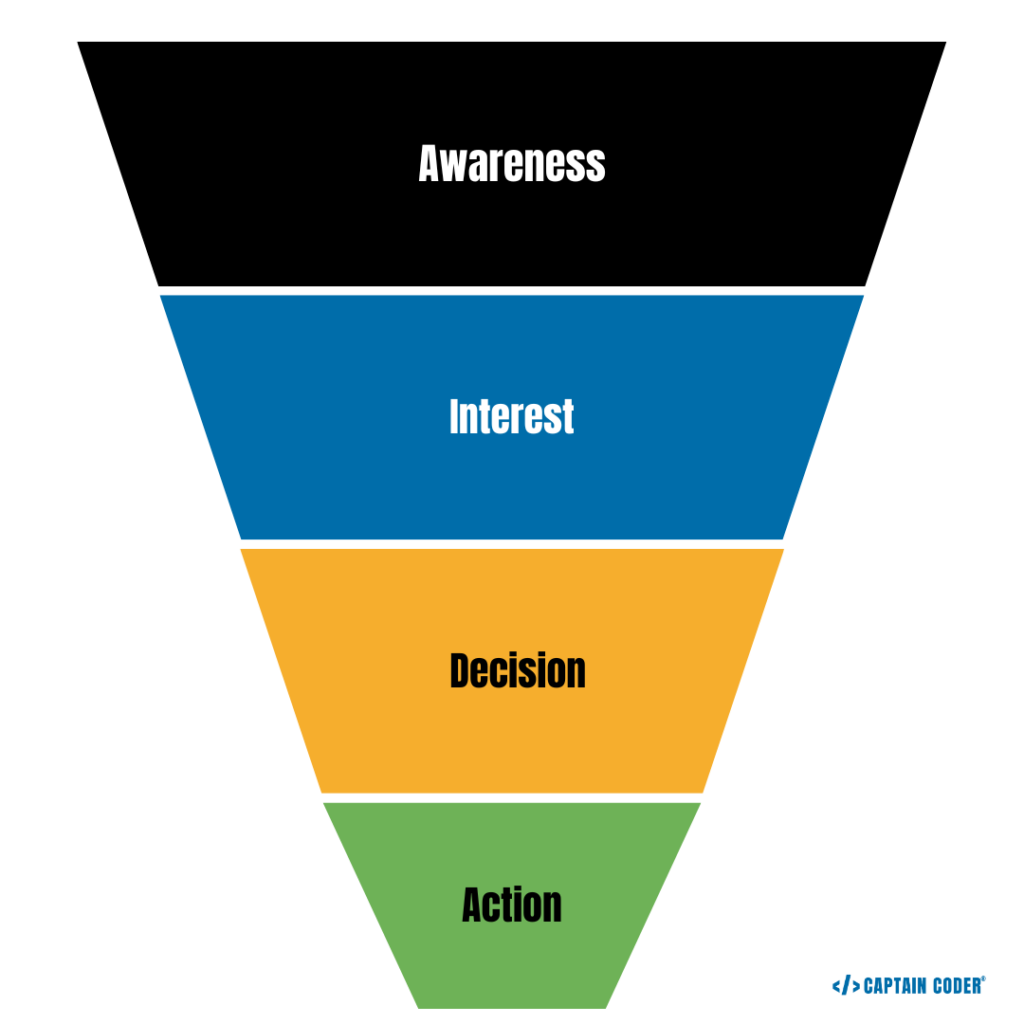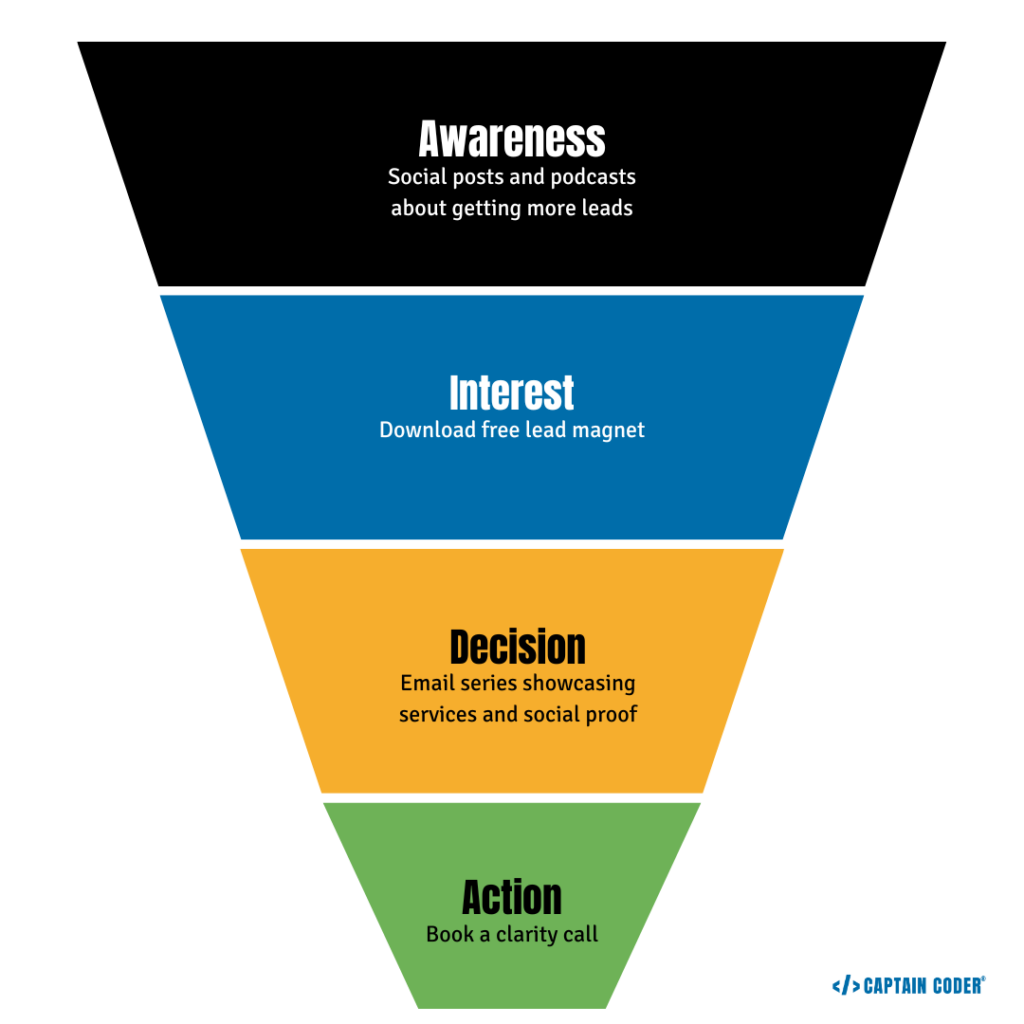Want to know one of the most confusing topics in today’s marketing? Marketing funnels. Online experts often talk about funnels and how they can help your business grow, but they very often break it down so you understand where to start.
Here’s why this is so frustrating to me – funnels don’t have to be overly complicated and they can be incredibly powerful to help you turn prospects into customers.
With a marketing funnel, you can improve your customer engagement, increase your conversion rates, and bring more people to your business.
So how does this all work?
Let’s dive into the basics of marketing funnels and how to implement one in your business.
What’s a Marketing Funnel, Anyway?
Put simply, a marketing funnel is a model of your customers’ journeys. It shows the stages people will go through after becoming aware of your business and service.
When you create a funnel for your business, you’re basically planning out how you want your customers to work with you and the steps you want them to take.
Creating a funnel allows you to control the customer journey and plan how you want them to move from discovering who you are and working with you.
Four Stages to a Marketing Funnel
When we talk about funnels, we use that term because you’re often going to lose people along the journey and it will narrow down to the ones that want to work with you.
Before you think – well how can I keep everyone in my funnel – you don’t want them to. Not everyone who discovers you online will be the right fit for your business. You want a few people to drop out so that you keep only the best customers.
The basic marketing funnel has four stages:
- Awareness: your customer literally becomes aware that you exist.
- Interest: they’re interested in learning more about your services.
- Decision: they’re ready to make a purchase and are evaluating their options.
- Action: this is where they actually make a purchase.

The great thing about understanding a marketing funnel and the stages that your customers will go through is that it makes it easier to create marketing content for each stage in your customers’ journeys.
You’re also able to better understand where you’re losing people, make tweaks where necessary, and lead them on a journey to working with you.
So how do we put this idea into action?
Marketing to the Top of the Funnel
I want you to step back for a second and think about the type of marketing content you’re creating for your business.
Are you focusing on multiple stages in the decision-making process, or are you simply throwing posts out there hoping that someone will work with you?
When we create content for a marketing funnel, we want to think about every stage that our potential buyers will go through.
Let’s take a look at the type of content that you should be creating for the top of your funnel.
Define Your Customer
First things first, we need to get really clear on who our customer is. If we don’t know who we’re talking to, it’s really difficult to get them to read anything you’re creating.
We covered this in-depth in episode 49, but the big thing to remember here is to know what problems they’re facing and what result they’d like to achieve – even if that result is simply a piece of mind.
Increase Brand Awareness
Now that we know who we’re talking to, we need to work to increase our overall brand awareness.
This can look like:
- Posting Reels and images on Instagram
- Engaging on others’ social media accounts
- Guesting on podcasts
- Writing helpful blog posts
- Answering questions in online communities like Facebook groups
- Speaking at local events
- Running social media ads
The important thing here is to pick two or three things that you can really focus on, make that consistent, and then build from there.
With your top-of-the-funnel, your main goal is to capture the attention of someone who might be interested in working with you and give them a reason to hit that follow or find out more about you.
Pro tip: move them from the top of the funnel to the middle by giving them a call to action so they’ll actually engage with you. Think of offering a free lead magnet they can sign up for and get on your email list.
Middle of the Funnel Marketing
Now that you have people aware of who you are, it’s time to have them make a decision about whether they want to stay connected with you.
This basically means that we need to keep them interested but also get them to move towards a buying decision of some kind.
How do we do that?
Educate and Keep them Connected
One of the best ways to move someone through the middle of your funnel is to show them how you’re different from your competitors.
You can do this by educating them about your services and your unique solutions, giving them some easy-to-follow tutorials following your framework (just enough for a quick win, not everything), and sharing your other customers’ success stories.
So what does middle-of-the-funnel marketing content look like?
This is:
- Your own podcast episode
- A case study from your clients
- Some kind of how-to guide or PDF download (your lead magnet!)
- Webinar
- Landing page
- Link posts in your Instagram stories
- Customer reviews/testimonials
- Discovery calls
The key in the middle of the funnel is to convince someone that you’re the right person to buy from.
The middle of the funnel is where you’re doing a lot of the work and generating the most touchpoints to convince someone to take it one step further into decision and action.
Get them to Take Action
Our last stage of a marketing funnel is to get our customers to choose to take action. Called the bottom of the funnel, this covers both the decision and action phases.
You’ve gotten in front of them and they’ve been watching your content for a while. Now it’s time to get them to choose to take that next step forward and actually work with you.
As a service-based business, the best way to do this is probably to get them on a call in the middle of the funnel and allow them to speak with you or your team and make a decision.
You can also use content to address some final objections, show detailed comparisons of your services vs. others, or even use some urgency to get them to buy.
(A note: urgency only works when it’s a real, limited-time deal. Don’t fake it or you’ll have Gen Z mad at you like they were mad at Target’s Black Friday deals on TikTok all weekend.)
Convert on a Landing Page
In a service-based business, most of your bottom-of-the-funnel marketing is going to happen on a landing page.
A page on your website that’s dedicated to this one buying decision, a landing page is where you’re going to fully convince someone to buy (or book a call with you so then they’ll buy).
With landing pages, you need to ensure that you’re covering objections, giving them a clear picture of how you’re going to help them, and showcasing social proof that backs up your claims.
If you’ve got people really interested in working with you but then you lose them in the end, it’s often that you’ve got issues on your landing page.
Examples of a Marketing Funnel
Now that we have an idea of how a marketing funnel works, how does a real-life one actually look?
In my own business, I use top-of-the-funnel content to get my customers interested in getting more leads in their business. I get them to move into the middle of the funnel by grabbing my free 10 Ways to Get More Leads download, then they get an email automation series that helps to answer their questions, showcase my services, and backs everything up with some social proof.
From there, they’re encouraged to sign up for a Clarity Call with me so that I can see what they actually need in their business and recommend the right service for them.

It’s pretty simple!
Another great example is You Need a Budget. This online SAAS company allows you to create a personal budget and teaches you how to manage your money better.
They generate interest in their company through SEO, ads, and social media, and then encourage you to hop into the middle of the funnel by signing up for a free trial.
This is a great way to get you to make a purchase decision because you get to try out how they work for free at no obligation to you.
Marketing funnels don’t have to be complicated. They just need to cover the main points in a buyer’s journey and encourage them to keep moving forward to working with you.
Don’t Forget to Build Loyalty
Here’s the part that many people forget: once someone has purchased from you, it doesn’t mean that your work is over.
An important part of the marketing process is to keep customers coming back to work with you more.
You can continue to build loyalty with your customers (and help them drive referrals to you), by just providing amazing customer service.
But if you want to take this one step further, you can provide discounts or affiliate commissions for referrals, content about how to get the most out of your service, or even quick tips that help them get some more quick wins.
Make Marketing Easier
The overall goal of a marketing funnel?
Make your marketing decisions easier!
When you’re focused on how you help people through every stage of your marketing and answering their questions, you’re going to move people from just following you on social media to working with you.
It takes a little careful planning and testing, but it can be incredibly worthwhile to build consistent leads into your business.



